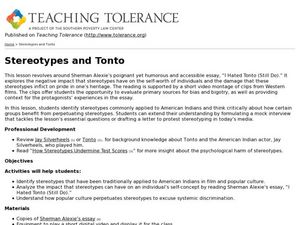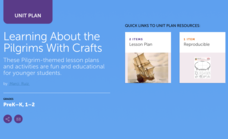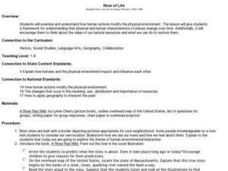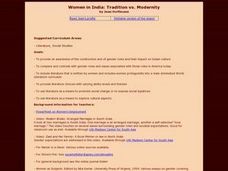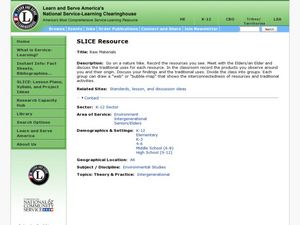Curated OER
Kids in the Colonies
Students compare and contrast family life in colonial America with life today. They describe what communities were like in colonial times and how they varied from life today. A spokesperson from each group will present a verbal report...
Curated OER
Stereotypes and Tonto
Students identify stereotypes, especially those applied to American Indians. In this teaching tolerance lesson, students read an essay entitled " I Hated Tonto (Still Do)" and discuss the negative impact that stereotypes may have on a...
Curated OER
Transportation and Mapping
Students view murals that depict various modes of transportation. They discuss the importance of maps to navigation and create a map. They compare and contrast transportation of the past with modes of transportation used today.
Curated OER
Where Does Maple Syrup Come From?
For this maple syrup worksheet, students read an informational article about the discovery of maple syrup, how we get maple syrup today, the "sugar house", how to grade it, and a recipe for a snow cone. Students answer nine true and...
Scholastic
Learning About the Pilgrims With Crafts
Students research the pilgrims in terms of why they left England, their voyage to America, the challenges they faced when they arrived, and their relationship with the American Indians. To conclude this unit, the students have a...
Curated OER
Environment: River of Life
Students assess the impact of human activity on the environment. After reading the book, "A River Ran Wild," they role-play and discuss how people changed the river. Students write stories about living along a river from the point of...
Curated OER
Making Decisions Every Day
Third graders discuss the importance of being able to make decisions on their own. Using information on Montana's Native American tribes, they develop their own supporting statements. They also discover techniques to determine if the...
Curated OER
The Turn of the Nineteenth Century: Lifestyles and Cultures
Student reflect on the differences between the life of children in the early
nineteenth century and their lives in the present. They demonstrate these differences by creating a drawing of "then and now." In addition, they create a...
Curated OER
The Importance of Buffalo Culture to Blackfeet Indians
Students examine importance of buffalo in culture of Blackfeet Indians, and explore types of technology used by Indians to kill large numbers of buffalo. Students research transition of Blackfeet from subsistence economy to capitalist...
Curated OER
Women in India: Tradition vs. Modernity
Students explore cultural aspects such as gender roles and their impact on Indian culture and compare and contrast issues associated with those roles in America through literature.
NET Foundation for Television
1850-1874 Railroads and Settlement
Have you ever wondered how your town was placed where it is? Scholars research the impact the advancement of the railroad due to the passage of the Kansas-Nebraska Act had on the formation of civilization in the Great Plains. Map...
Curated OER
The Battle of Horseshoe Bend: Collision of Cultures (54)
Students discover the political and cultural conflicts that led to the Battle of Horseshoe Blend, Alabama, and evaluate historical maps of the Battle of Horseshoe Bend. They research American Indian cultures that were located in their...
Curated OER
How Does Technology Affect Me?
Students compare and contrast the tools used by Native Americans from the Paleo, Archaic and Woodland periods. The visit and discuss a website describing inventions and the problems they solved. They use this historical information to...
Curated OER
Corn Cob Toys
Students make toys from corn cobs. They study the many uses for corn, both historically and today. They write a description of the toy/object he or she has made and provide instructions for making it. They write and perform plays,...
Curated OER
The Heritage of Puerto Rico and Cuba
Students examine the influences of the Hispanic culture in the United States. In groups, they read about the life of a slave in Cuba and identify the misconceptions are discussed. As a class, they define racism, read an essay and...
Curated OER
Raw Materials
Students participate in a nature hike and record the natural resources observed. They compare traditional and modern versions of everyday use items, and create graphic organizers that demonstrate the interconnectedness of resources.
Hello-Hello
Spanish – Learn Spanish (Hello-Hello)
Pick up basic conversational Spanish with animated videos featuring three characters: Pablo, Ana, and Marcos. As Pablo and Marcos get to know Ana, they talk about a variety of subjects. Learners can acquire the vocabulary in each...
Curated OER
Who Needs It?
Fourth graders explain the needs and wants of an Abenaki family or group and/or of a family or group in the first half of the 19th century and compare them to the needs and wants of Students' family or household today.
Curated OER
Mapping the New World Lesson Plan
Young scholars compare two maps of the same area from different time periods. In this American History lesson, students look at two maps of the English colonies from 1636 and 1651. They discuss why the maps changed and predict maps from...
Curated OER
Social Studies: The Lewis and Clark Trail Today
Students locate present-day towns along the Lewis and Clark Trail and compare them to towns in 1800, 1900, and 2,000. Working in groups, they conduct Intenet research to locate the wons along the trail and research their history and...
Curated OER
Topsy Turvy Kids
Sixth graders study the artwork of Jaune Quick-to-See Smith before creating their own. In this painting lesson, 6th graders examine two pieces of work by Jaune Quick-to-See from the online collection of the Missoula Art Museum and read a...
Curated OER
Shiloh Quiz
In this online interactive Civil War worksheet, students respond to 15 multiple choice questions about the Battle of Shiloh. Students may check their answers immediately.
Curated OER
What Did You Say?
Students investigate how the Indians and Europeans first met and their first interactions using spoken language. Before speaking the class warms up to the idea with the use of body language and gestures. Then the teacher sets the scene...
Bette Brooks
"No Irish Need Apply..."
Students describe conditions that led to massive immigration from Ireland in the 1840s, and compare response of native-born Americans to Irish immigration with responses to Mexican immigration today.



